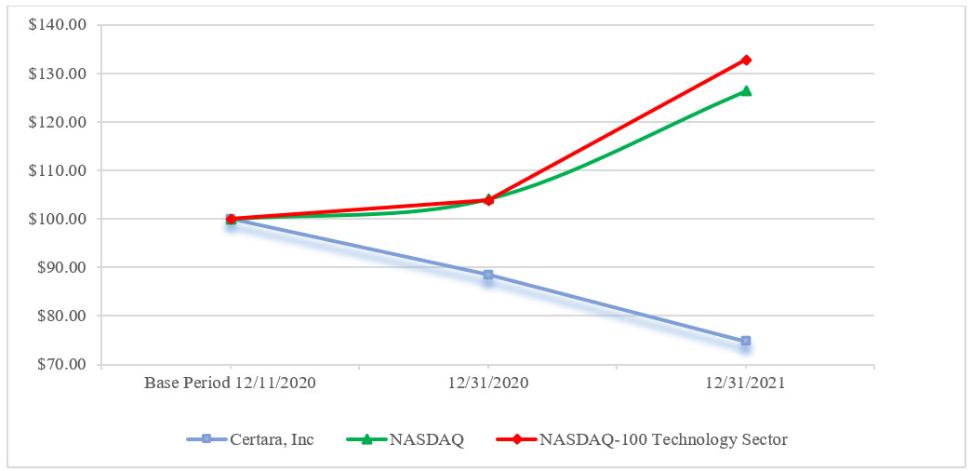CERTARA, INC. AND SUBSIDIARIES
NOTES TO THE CONSOLIDATED FINANCIAL STATEMENTS
(IN THOUSANDS, EXCEPT PER SHARE PERCENTAGES AND SHARE AND UNIT DATA)
1. Description of Business
Certara, Inc. and its wholly-owned subsidiaries (together, the “Company”) deliver software products and technology-driven services to customers to efficiently carry out and realize the full benefits of biosimulation in drug discovery, preclinical and clinical research, regulatory submissions and market access. The Company is a global leader in biosimulation, and the Company’s biosimulation software and technology-driven services help optimize, streamline, or even waive certain clinical trials to accelerate programs, reduce costs, and increase the probability of success. The Company’s regulatory science and market access software and services are underpinned by technologies such as regulatory submissions software, natural language processing, and Bayesian analytics. When combined, these solutions allow the Company to offer customers end-to-end support across the entire product life cycle. On October 1, 2020, the Company amended the certificate of incorporation of EQT Avatar Topco, Inc. to change the name of the Company to Certara, Inc.
The Company has operations in the United States, Canada, Spain, Luxembourg, Portugal, United Kingdom, Germany, France, Netherlands, Denmark, Switzerland, Italy, Poland, Japan, Philippines, India, Australia and China.
2. Summary of Significant Accounting Policies
(a) Basis of Presentation and Use of Estimates
The preparation of consolidated financial statements in conformity with U.S. generally accepted accounting principles (“GAAP”) requires management to make estimates and assumptions that affect the reported amounts of assets, liabilities, disclosure of contingent assets and liabilities at the date of the consolidated financial statements and the reported amounts of revenues and expenses during the reporting period. Significant estimates include, among other estimates, assumptions used in the allocation of the transaction price to separate performance obligations, estimates towards the measure of progress of completion on fixed-price service contracts, the determination of fair values and useful lives of long-lived assets as well as intangible assets, goodwill, allowance for credit losses for accounts receivable, recoverability of deferred tax assets, recognition of deferred revenue, value of interest rate swaps, determination of fair value of equity-based awards and assumptions used in testing for impairment of long-lived assets. Actual results could differ from those estimates, and such differences may be material to the consolidated financial statements.
(b) Recently Adopted Accounting Pronouncements
In October 2021, the Financial Accounting Standards Board (“FASB”) issued Accounting Standards Update (“ASU”) 2021-08, “Business Combinations (Topic 805) - Accounting for Contract Assets and Contract Liabilities from Contracts with Customers”, which requires that at the acquisition date, an acquirer should account for the related revenue contracts in accordance with ASC Topic 606, “Revenue from Contracts with Customers” (“Topic 606”), as if it had originated the contracts. Generally, this results in an acquirer recognizing and measuring the acquired contract assets and contract liabilities consistent with how they were recognized and measured in the acquiree’s financial statements if the acquiree prepared financial statements in accordance with U. S. GAAP. For public business entities, the ASU is effective for fiscal years beginning after December 15, 2022, including interim periods within those fiscal years. Early adoption of the ASU is permitted. The Company early adopted ASU 2021-08 early and has carried over the contract assets and liabilities from the 2021 business acquisitions into the Company’s 2021 consolidated financial statements.
In December 2019, the FASB issued ASU 2019-12, "Simplifying the Accounting for Income Taxes" which removes certain exceptions related to the approach for intraperiod tax allocation, the methodology for calculating income taxes in an interim period and the recognition of deferred tax liabilities for outside basis differences. The Company adopted this guidance on January 1, 2021 on a prospective basis. The adoption of this guidance did not have an impact on the Company's consolidated financial statements.
